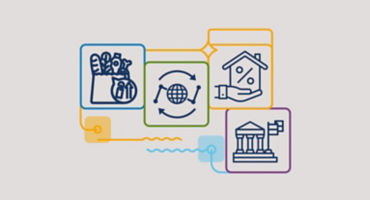- Fixed Income Portfolio Manager
Skip to main content
- Funds
- Insights
- Capabilities
- About Us
- My Account
The views expressed are those of the authors at the time of writing. Other teams may hold different views and make different investment decisions. The value of your investment may become worth more or less than at the time of original investment. While any third-party data used is considered reliable, its accuracy is not guaranteed. For professional, institutional, or accredited investors only.
Bonds that finance specific sustainability-focused projects or activities — also known as use-of-proceeds bonds — are on the rise and becoming an increasingly common part of an investor’s toolkit. Green bonds remain the most popular form of use-of-proceeds bond, but blue bonds, which aim to support projects related to ocean protection and conservation, are catching the eyes of investors looking to make a positive difference with their capital.
How exactly do blue bonds work and how effective are they? We met with Will Prentis and Campe Goodman to examine the opportunity and discuss how fixed income investors can best have an impact on ocean conservation.
Will: While green bonds traditionally finance projects related to broad environmental objectives, such as alternative energy sources, improved resource efficiency or promoting a circular economy, blue bonds raise capital for projects specifically supporting the blue economy: the sustainable use of ocean resources for economic growth, improved livelihoods and jobs while preserving the health of the ocean ecosystem.
Blue bonds can be issued by sovereigns, development banks, corporates or other organisations. The bond issuers use the proceeds to finance projects such as the conservation and restoration of coral reefs, the development of sustainable fisheries and the reduction of plastic waste in the oceans. For investors, blue bonds offer a way to potentially earn a financial return while also supporting sustainable development and environmental conservation.
Will: Our oceans and seas play a crucial role in the world's economy, driving sectors such as fishing, transport, tourism and renewable energy. The oceans not only provide natural resources but also employment for millions of people. Data from the UN Global Compact estimates that the blue economy represents around 2.5% of global GDP — comparable to a country in its own right.
Our oceans are under stress from overexploitation, pollution, declining biodiversity and climate change. For the productive use of our oceans to continue and for individuals to continue to benefit from economic growth and improved livelihoods, the health of the ocean ecosystem must be preserved.
Yet SDG 14: Life Below Water, receives the lowest long-term funding of any of the UN Sustainable Development Goals (SDGs).
There is a critical funding gap for an environmental challenge that disproportionately affects the world’s poorest. For example, inhabitants of smaller island states, which have vast ocean resources at their disposal and an enormous opportunity to boost their economy through the oceans, have the most to lose from the degradation of marine resources — through the loss of income and jobs due to their economy’s reliance on fisheries or tourism.
Will: Governments, companies and investors are beginning to recognise the important role the blue economy plays in broader environmental and social outcomes. In March this year, after nearly two decades of talks, the UN finally reached a historic agreement on protecting marine biodiversity. This is a huge step forward, but I think it's also a sign of how much work there is ahead of us.
There’s also a growing awareness of the relationship between climate change and our oceans: it’s estimated that oceans absorb 30% of global carbon emissions4, and so the health of the oceans is critical in supporting the green transition.
Market participants are also recognising the magnitude of the financing required, as well as the extent of the opportunity within the world’s largest asset class. Blue bond issuance to date has been relatively scarce and mostly led by development banks and select sovereigns: the World Bank assisted the Seychelles in launching the world’s first sovereign blue bond in 2018. However, we’ve recently also seen corporate issuers express interest in the structure.
Campe: There’s a real need for investment in the blue economy. Bonds dedicated to ocean conservation should be, in some form, part of the solution to keeping our oceans healthy.
However, we’ve seen time and again that innovations in sustainable investing need time to mature. We approach new ideas with prudence and careful analysis, and we firmly believe in making our own independent assessments of every bond and issuer that we consider. A label — even from a well-known sustainability-rating company— doesn’t guarantee impact.
For each bond we analyse, we determine the fit with the three key tenets of our impact philosophy: materiality, additionality and measurability. We ask: to what extent are the bond’s proceeds aligned with our impact themes? Is financing directed towards ongoing or future projects? Are the projects going above and beyond the ordinary course of business? Can we measure and track key performance indicators of impact?
One area where we remain cautious: the debt-for-nature swap. This type of structured deal typically involves a creditor providing a government with debt relief in return for a commitment to use some of the debt savings to finance ocean conservation. Such an arrangement sounds appealing because it can, ideally, benefit investors, borrowers and the ocean. Because the structure is complex, however, it’s typically expensive to implement. In many cases, the benefit for the blue economy appears to us to be small relative to the size of the transaction. With only a fraction of blue bond proceeds being directed towards ocean-related projects, we’re often sceptical of the current generation of blue bonds that contain debt-for-nature swaps, despite our strong wish to be enthusiastic champions of this new structure.
As we look forward, we see reason for hope. An increasing number of blue bonds are issued under the more traditional use-of-proceeds structure, like green bonds. As blue bond structures become simpler and more standardised, investors like us should find it easier to measure and report on the impact that our investments are having.
Of course, a solid impact proposition is only the first step in our purchase decision. We perform thorough credit analysis on every potential bond investment to determine whether it can deliver on financial, as well as impact, objectives.
Will: We expect further interest in blue bonds, especially against the backdrop of the UN’s recent historic agreement to protect marine biodiversity. Market participants are becoming more aware of the magnitude of financing required, as well as the extent of the opportunity.
Corporate blue bond issuance remains relatively scarce, in part due to the novelty of the structure, as well as the fact that corporate issuers typically have less direct exposure to ocean-related risks and opportunities. However, we expect to see further corporate issuance as the market adopts improved standards on structure and disclosure. Investor demand may well increase as structures become simpler and more transparent.
Campe: Growth and innovation in blue bonds is a prime example of how the supply of impact investments is increasing in the public fixed income markets. We believe today’s green bond market is larger and higher quality than the green bond market of five years ago, and we’re optimistic that blue bonds will follow a similar arc. Guidance from regulators and rating firms, feedback from sustainable investors and convergence in blue bond structures will catalyse greater investment in the blue economy.
Label or not, we continue to advocate a bottom-up, research-driven approach to impact investing. We believe in taking a thoughtful, independent approach to each investment opportunity, and in putting capital to work to meet both impact and financial objectives.
1United Nations Global Compact | 2OECD | 3World Resources Institute | 4OECD
Stay up to date with the latest market insights and our point of view.
Fed’s projections yielded mixed results this year — what’s in store for 2024?
Our Fed watcher opines on 2023 policy and looks ahead to 2024.

Macro implications of the AI revolution: is the market right?
Macro Strategist John Butler sets out an initial framework to help answer key questions about the potential macro impact of artificial intelligence.
Fed not yet willing to declare victory on inflation
We think the Fed is done raising rates for this cycle, despite the likelihood that they are being overly optimistic about inflation. Read to find out why.
How to interpret the Bank of Japan’s latest policy shift
We analyse the wide-ranging investment implications of the Bank of Japan's latest policy shift.
US loses its AAA rating (again)
US Macro Strategist Michael Medeiros analyzes Fitch's recent downgrade of US credit quality and explores the bigger issues at play.
New BOJ governor: Dove, hawk… or owl?
Investment Director Masahiko Loo and Client Portfolio Manager Jitu Naidu discuss potential implications of the upcoming “changing of the guard” at the BOJ.

URL References
Related Insights